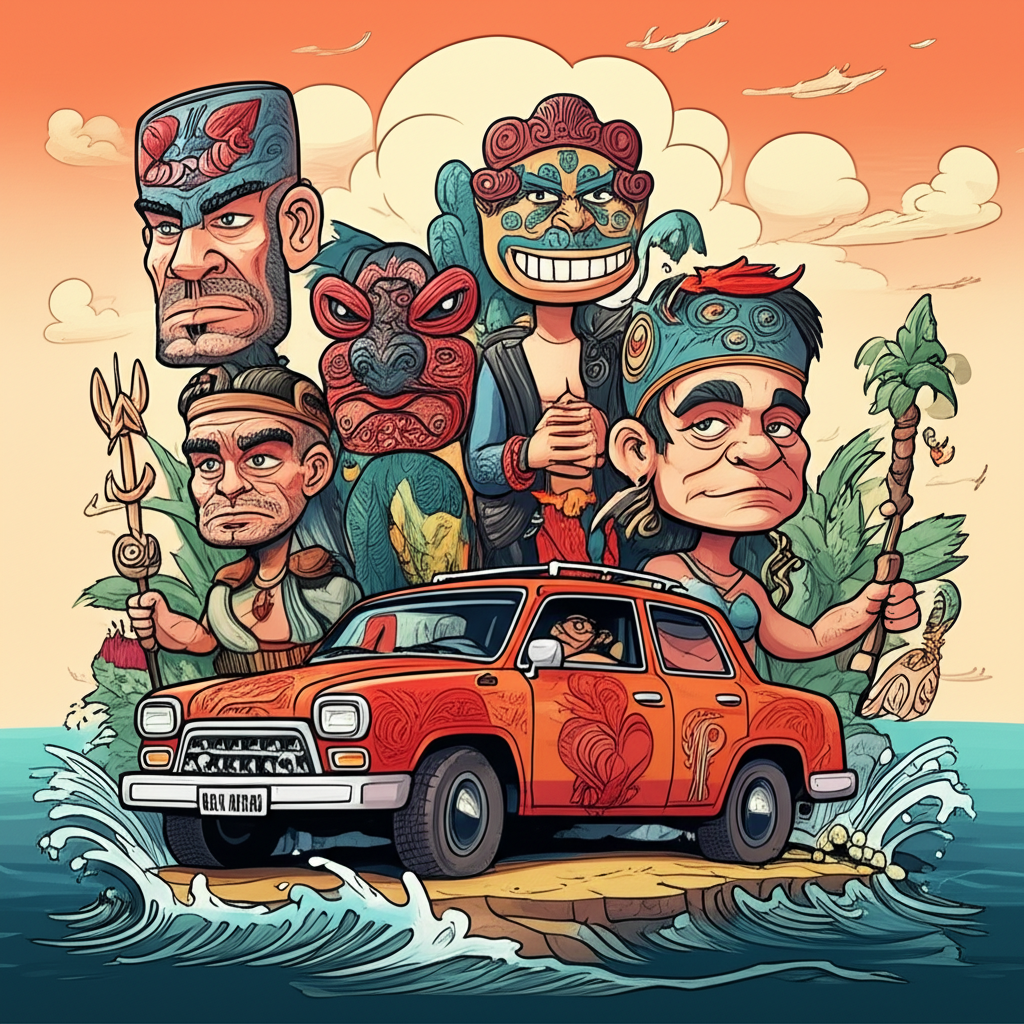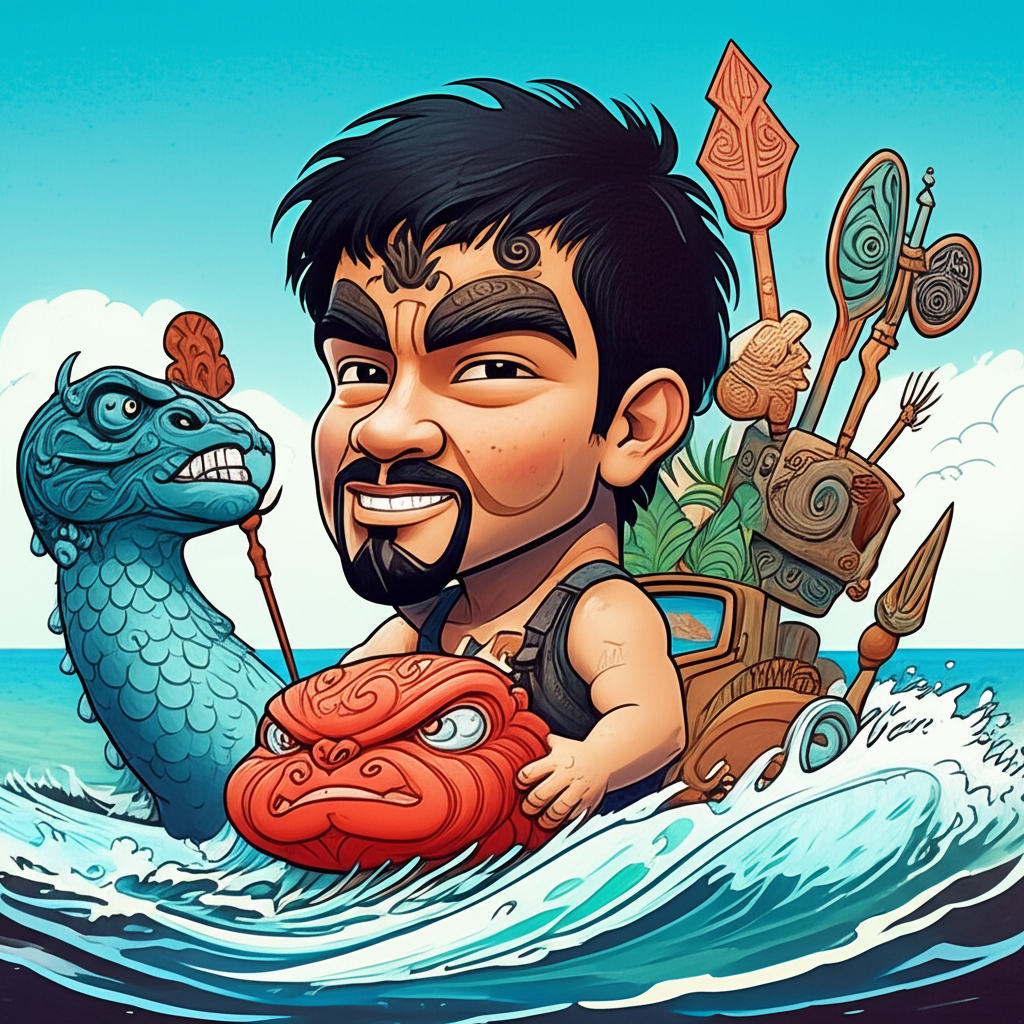
The vast, untamed Pacific Ocean has long been a source of wonder and respect for the peoples who have called its scattered islands home. Along the rugged, windswept coasts of Aotearoa, the land of the long white cloud, ancient storytellers wove tales of the deep, of the creatures that inhabited its mysterious depths, and of the primal forces that shaped their world. Among these narratives, the legend of Hina and the shark gods stands as a powerful testament to the profound connection between humanity and the natural world, a story passed down through generations, echoing with the wisdom and fears of the past.
It is crucial to understand that these are traditional stories, born from the rich tapestry of oral history and cultural understanding of the ancient Māori people. They are not to be taken as literal truths or divine pronouncements, but rather as profound allegories and symbolic expressions of a people’s worldview.
Origins and Cultural Background: A World of Tangaroa’s Dominion
The narratives of Hina and the shark gods emerge from a cultural epoch when the Māori people were deeply intertwined with their environment. Their lives were dictated by the rhythms of the sea, the bounty of the land, and the ever-present forces of nature. This was a society that viewed the world as alive, imbued with mana (spiritual power or authority) and overseen by ancestral deities. The ocean, in particular, was seen as the domain of Tangaroa, the god of the sea, a powerful entity whose moods and temperaments directly influenced the lives of coastal communities.
In this worldview, the natural world was not merely a backdrop to human existence, but an active participant, filled with beings both benevolent and fearsome. Animals, especially those with significant power or presence, were often imbued with spiritual significance. Sharks, with their sleek power, ancient lineage, and predatory prowess, held a particular fascination and awe. They were seen as formidable beings, capable of both immense destruction and, in some interpretations, offering protection or guidance.
Character/Creature Description: The Majestic and the Mysterious
Within these ancient narratives, Hina emerges not as a divine being in the traditional sense, but as a figure of profound human experience and transformation. She is often depicted as a woman of great beauty and resilience, whose journey through hardship and sorrow leads her to a pivotal encounter with the ocean’s rulers.
The "shark gods," as they are sometimes referred to, are not necessarily individual deities in the same vein as Tangaroa. Rather, they represent the archetypal power and spirit of sharks themselves. They embody the raw, untamed energy of the ocean, its capacity for both life-giving sustenance and swift, decisive action. Their symbolic attributes lie in their strength, their silent efficiency, their connection to the ancient mysteries of the deep. They are creatures of instinct, guardians of their domain, and often, in the context of these myths, possess a primal wisdom that transcends human understanding. They are not worshipped, but respected for their formidable presence and their integral role in the oceanic ecosystem.
Main Story/Narrative Retelling: Hina’s Descent and the Sharks’ Embrace
The tale of Hina often begins with her plight. One prominent version tells of Hina, a woman of exceptional beauty who suffers greatly at the hands of her brothers. In her despair and flight from their cruelty, she throws herself into the sea. It is here, in the vast embrace of Tangaroa’s realm, that her transformation begins.
The ocean, with its powerful currents and hidden depths, becomes a crucible for her pain and her courage. It is said that Hina, through her resilience and perhaps through a spiritual connection forged in her distress, encounters the great shark gods. These are not monstrous beasts in the traditional sense, but rather beings of immense power and ancient wisdom. They are the embodiment of the ocean’s untamed spirit.
In some retellings, the shark gods are initially perceived as fearsome. Yet, Hina, stripped of her earthly troubles and immersed in the primal world, finds a strange kinship with these creatures. They are said to carry her, to protect her, to guide her through the currents. She is transformed by this experience, becoming a being deeply connected to the ocean, a symbol of survival and adaptation.
Another facet of these stories might involve Hina’s connection to the moon. In some versions, Hina is associated with the moon goddess, Rongo-mā-Tāne, or her celestial journey. The sharks, in their mysterious movements and their presence in the deep, are sometimes linked to the lunar cycles and the tides, further weaving them into the fabric of the natural and celestial world.
The narrative is not one of divine intervention in the sense of worship, but a powerful story of survival, transformation, and the profound, often awe-inspiring relationship between humans and the natural world. Hina’s journey is a metaphor for overcoming adversity and finding strength in unexpected places, even within the perceived ferocity of nature.
Symbolism and Meaning: The Ocean’s Wisdom and Human Resilience
For the ancient peoples of Aotearoa, stories like these served as vital vessels for transmitting knowledge, values, and a worldview. The Hina narrative, with its shark god motif, could have represented several layers of meaning:
- The Power and Mystery of Nature: The sharks, as formidable creatures of the deep, embodied the untamed power and inherent mystery of the ocean. Their presence in the story highlighted the respect and caution with which the people approached the sea, a source of both sustenance and danger.
- Resilience and Transformation: Hina’s journey from suffering to survival and eventual spiritual connection symbolized the human capacity for resilience in the face of adversity. Her transformation in the ocean could represent a shedding of earthly troubles and an emergence into a state of greater strength and wisdom.
- Balance and Interconnectedness: The story could underscore the interconnectedness of all life. Humans, the ocean, and its inhabitants were not separate entities, but parts of a larger, intricate web. The shark gods, in their symbolic role, represented a primal force that was integral to this balance.
- Guidance and Protection (in a symbolic sense): While not divine saviors, the sharks’ "embrace" of Hina could symbolize finding protection and guidance within the forces of nature when all else fails. It speaks to a belief that even in perceived danger, there can be a form of support if one understands and respects the natural order.
Modern Perspective: Echoes in Contemporary Culture
The rich tapestry of Māori mythology continues to resonate in contemporary Aotearoa and beyond. The legend of Hina and the shark gods, though rooted in ancient oral traditions, finds echoes in various modern mediums. In literature, Māori writers and scholars often draw upon these ancestral stories to explore themes of identity, heritage, and the enduring connection to the land and sea. These narratives are frequently retold in children’s books, enriching the cultural education of younger generations.
In visual arts, the imagery of sharks and the ocean is a recurring motif, often infused with the symbolic weight of these ancient legends. While not directly a focus of mainstream Hollywood productions, the archetype of powerful, primal ocean beings certainly influences storytelling in films and video games, albeit often in a more generalized, less culturally specific manner. Cultural studies and anthropology departments globally examine these myths as vital windows into the indigenous worldview of the Māori people, offering insights into their cosmology, social structures, and their deep respect for the natural world.
Conclusion: A Legacy of Storytelling
The tale of Hina and the shark gods of Aotearoa’s shores is a profound example of the enduring power of cultural storytelling. It is a narrative born from the ancient imagination of the Māori people, a testament to their deep understanding of the natural world and their capacity to weave profound meaning from the observed realities of life.
As Muslims, we recognize that only Allah (SWT) is the true Creator and Sustainer of all existence. Our faith teaches us that all power and authority reside solely with Him. These ancient stories, therefore, are understood within their cultural and historical context, not as claims of divine power or factual accounts, but as rich expressions of human experience, imagination, and a particular way of understanding the world.
The legacy of these myths lies not in belief, but in their ability to connect us to the past, to inspire creativity, and to remind us of the universal human impulse to make sense of the world around us through the timeless art of storytelling. The echoes of Hina and the majestic, mysterious sharks of Aotearoa’s shores continue to whisper across time, a reminder of the vibrant cultural heritage and the boundless power of human imagination.





